Your sleep cycle wearable tracks multiple physiological signals throughout the night, including movement patterns through accelerometry, heart rate variability via PPG sensors, and breathing rhythms. It monitors sleep stages by detecting when you’re in light, deep, or REM sleep based on heart rate fluctuations and body movements. Environmental factors like ambient light, noise levels, and temperature are also measured. These devices calculate sleep efficiency, total duration, wake periods, and sleep onset timing to provide thorough insights into your nightly rest patterns and overall sleep quality trends.
Core Sleep Metrics Measured by Wearable Devices
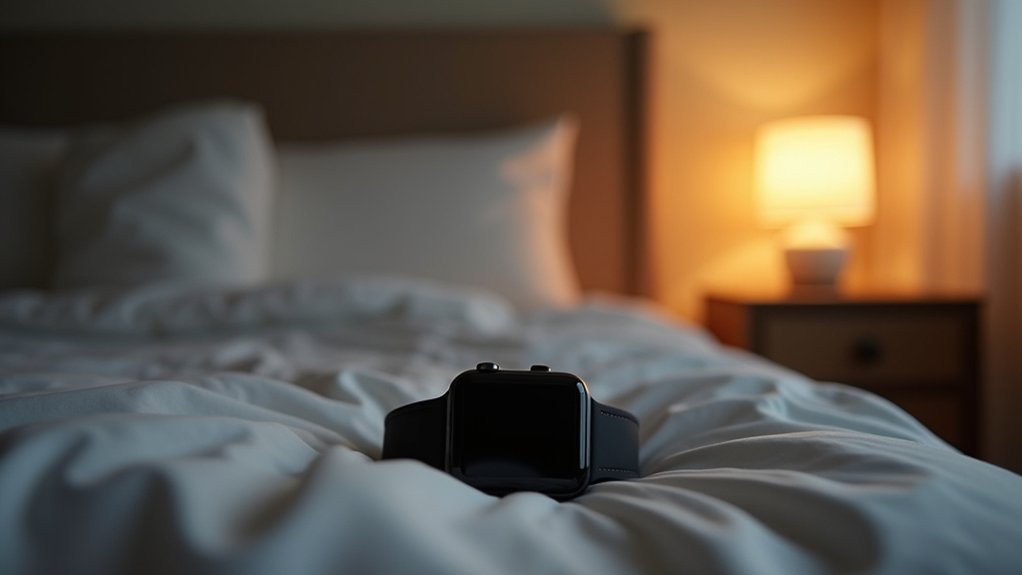
Wearable devices capture several fundamental sleep metrics that provide insights into your nightly rest patterns.
Your sleep efficiency represents the percentage of time you’re actually asleep while in bed, which directly indicates rest quality. These devices track your total sleep duration and attempt to classify different sleep stages including light, deep, and REM sleep, though accuracy varies greatly.
You’ll also get data on sleep onset and latency—the time from bedtime to actually falling asleep. However, this measurement can be inaccurate if your device isn’t properly calibrated or mistakes stillness for sleep.
Additionally, wearables monitor your wake-up time and any sleep interruptions throughout the night. Automatic tracking now allows these devices to monitor health metrics without user intervention. While these metrics offer valuable insights into your sleep patterns, it’s important to understand their limitations compared to clinical sleep studies.
Sensor Technologies Behind Sleep Tracking Capabilities
Your sleep tracker’s capabilities stem from sophisticated sensor technologies that work together to decode your nightly rest patterns.
These devices primarily rely on three core sensing approaches: movement detection technology that captures your body’s motion and stillness throughout the night, heart rate monitoring systems that track your cardiovascular rhythms, and environmental sensing capabilities that measure external factors affecting your sleep quality.
Understanding how these sensors function will help you maximize your device’s potential and interpret your sleep data more effectively. Advanced trackers also monitor blood oxygen levels continuously during sleep to provide comprehensive health insights alongside traditional sleep metrics.
Movement Detection Technology
Modern sleep cycle wearables rely on accelerometry as their foundational technology, detecting your body’s movement patterns to distinguish between sleep and wake periods. These devices use tri-axial movement detection, monitoring motion across three dimensions to improve accuracy in sleep-wake discrimination.
| Generation | Technology | Limitations |
|---|---|---|
| First Generation | Basic accelerometry | Misclassifies motionless wake periods as sleep |
| Second Generation | Multi-sensor integration | Reduced false positives through additional data |
| Advanced Systems | Machine learning algorithms | Enhanced sleep stage classification accuracy |
However, motion-based tracking faces inherent challenges. You’ll find these devices struggle when there’s minimal movement, making it difficult to differentiate between actual sleep and quiet wakefulness. Advanced wearables now employ sophisticated algorithms and machine learning techniques to analyze movement patterns more precisely, enabling better estimation of different sleep stages like deep sleep through refined data processing methods. Leading sleep tracking applications have demonstrated their reliability through extensive data collection, with some platforms analyzing three billion sleep sessions to continuously refine their tracking accuracy.
Heart Rate Monitoring
Beyond movement detection, heart rate monitoring serves as a critical physiological indicator that transforms how sleep wearables assess your sleep quality and stages.
PPG sensors illuminate your skin with LEDs and measure reflected light to detect blood volume changes, tracking your cardiovascular activity throughout the night.
Your wearable uses heart rate variability (HRV) to reveal how your autonomic nervous system responds during different sleep phases:
- Deep sleep recovery – Your heart rate drops considerably, signaling restorative sleep
- REM sleep detection – Increased variability indicates dream-rich sleep stages
- Sleep onset timing – Subtle changes pinpoint when you actually fall asleep
- Stress assessment – HRV patterns reveal whether you’re truly recovering overnight
- Breathing irregularities – Heart rate fluctuations can detect potential sleep apnea episodes
Combined with movement data, this creates thorough sleep stage analysis. Some devices now incorporate FDA-cleared features that can identify serious sleep disorders like sleep apnea.
Environmental Sensing Capabilities
How do sleep wearables understand the environment around you while you rest? These devices employ multiple sensor technologies to monitor your surroundings and enhance your sleep quality.
Light sensors detect ambient brightness levels, helping adjust your sleep environment and track circadian rhythms. Noise detection capabilities evaluate sound disturbances that might affect your rest quality.
Advanced devices integrate accelerometers and gyroscopes to monitor movement patterns, while some incorporate functional near-infrared spectroscopy (fNIRS) technology to track brain activity and sleep stages. Modern wearables now feature pulse oximeter technology to detect breathing irregularities and monitor for sleep apnea conditions.
Temperature and humidity sensors monitor environmental conditions that impact sleep comfort.
Many wearables connect with smart home systems, automatically adjusting lighting and temperature. They’ll analyze multisensory data to provide personalized recommendations, helping you create ideal sleep conditions for better rest quality.
Sleep Stage Detection and Classification Methods
You’ll find that sleep tracking wearables combine data from multiple sensors—typically PPG heart rate monitors and accelerometers—to estimate which sleep stage you’re experiencing at any given time.
However, these consumer devices can’t match the clinical accuracy of EEG-based polysomnography, which remains the gold standard for sleep stage detection with up to 90% accuracy compared to wearables’ 70-80% range.
The algorithms powering your device face significant limitations since they’re working with indirect physiological signals rather than direct brain activity measurements. Performance can also be affected by individual characteristics such as skin color and obesity, which may impact the device’s ability to accurately detect physiological signals.
Sensor Data Combination Methods
While individual sensors provide valuable sleep data, modern wearables achieve more accurate sleep stage detection by combining multiple sensor inputs through sophisticated fusion methods.
Your device doesn’t rely on just one data stream—it strategically merges accelerometer motion data with PPG-derived heart rate variability to paint a complete picture of your sleep architecture.
Multi-sensor fusion validates findings across different physiological signals, reducing false classifications that plague single-sensor approaches.
Here’s what this integration reveals about your nightly rest:
- Cross-validation eliminates conflicting data between motion and cardiac signals
- Pattern recognition identifies subtle REM characteristics your body exhibits unconsciously
- Arousal detection catches brief awakenings you won’t even remember
- Stage shifts are mapped with greater precision than individual sensors allow
- Environmental artifacts get filtered out through intelligent data comparison
This sensor symphony transforms raw biological signals into meaningful sleep insights. These measurements provide sleep estimates rather than the precise brain wave monitoring found in professional medical sleep studies.
Clinical Accuracy Comparisons
All that sophisticated sensor fusion means nothing if your wearable can’t accurately interpret what’s happening during your sleep cycles.
When researchers compare consumer wearables against clinical polysomnography—the gold standard for sleep measurement—the results reveal significant accuracy gaps.
Your wearable excels at detecting when you’re asleep, typically achieving 93% or higher sensitivity. However, it struggles with wake detection, managing only 18-54% specificity.
The Oura Ring currently leads four-stage sleep classification, outperforming Apple Watch by 5% and Fitbit by 10%.
Most devices show only moderate agreement with clinical measurements, with Cohen’s κ scores ranging 0.4-0.6. Commercial wearables need better sensitivity to accurately detect sleep stages.
Distinguishing between light and deep sleep remains particularly challenging, and fragmented sleep further degrades accuracy across all consumer devices.
Algorithm Estimation Limitations
Behind every sleep stage notification on your wearable lies a complex algorithm making educated guesses about your brain activity using indirect measurements. Your device doesn’t actually know when you’re in REM or deep sleep—it’s interpreting motion patterns and heart rate changes to make its best estimate.
These algorithms face significant challenges that affect what you see each morning:
- Your quiet wakefulness gets misclassified as sleep since accelerometers can’t detect mental activity.
- REM and light sleep stages blur together without direct brain wave measurements.
- Brief awakenings disappear from your sleep report due to algorithmic smoothing.
- Individual differences get ignored by fixed thresholds that don’t account for your unique physiology.
- Environmental noise confuses sensors, creating artifacts in your sleep data.
Heart Rate Monitoring Throughout Sleep Cycles
Most sleep cycle wearables use photoplethysmography (PPG) sensors to continuously monitor your heart rate throughout the night, detecting subtle changes in blood volume that reveal your cardiovascular rhythms.
These sensors, typically positioned on your wrist or finger, capture beat-to-beat cardiac data that’s essential for determining which sleep stage you’re experiencing.
Your heart rate naturally fluctuates during different sleep phases. During deep sleep, you’ll see lower heart rates and increased heart rate variability (HRV), while REM sleep and wake periods show elevated rates.
Devices like the Oura Ring 4 and WHOOP 4.0 combine this heart rate data with other metrics like skin temperature and movement to create thorough sleep scores.
This continuous monitoring allows your wearable to track long-term sleep trends and provide personalized health insights.
Movement and Position Tracking During Rest
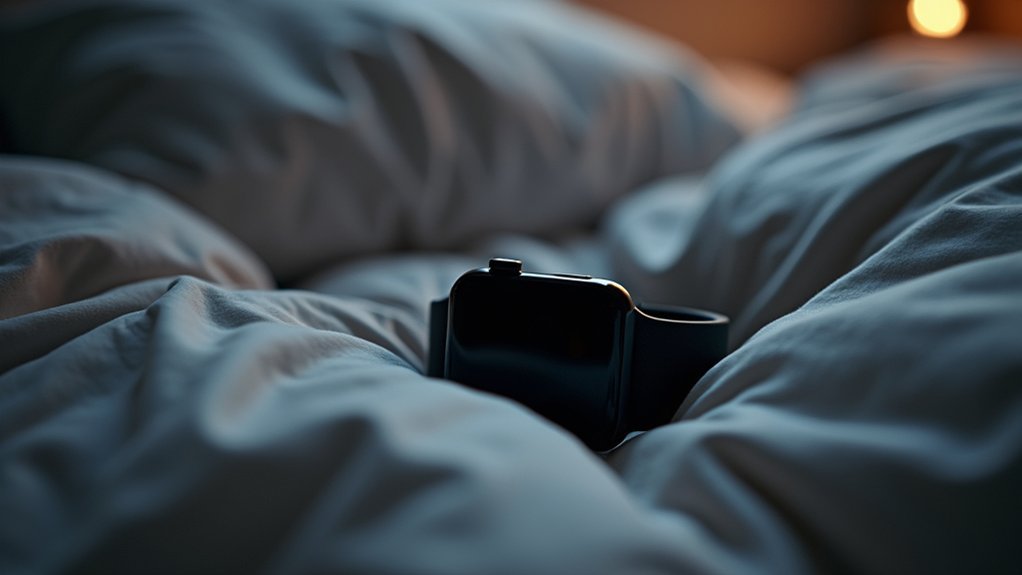
Your sleep tracker’s accelerometer constantly monitors how much you move and shift positions throughout the night.
These sensors detect motion in multiple directions, allowing the device to distinguish between periods of restlessness and stillness.
When you change from side to back or toss and turn frequently, the accelerometer data helps paint a picture of your sleep quality and potential disruptions.
Accelerometer Motion Detection
Accelerometers within sleep tracking wearables capture your body’s triaxial movements throughout the night, transforming subtle shifts and stillness into valuable sleep insights. These sensors continuously monitor motion patterns, detecting when you’re restless versus deeply asleep. Less movement indicates deeper sleep phases, while frequent motion suggests lighter sleep stages.
Advanced algorithms analyze this data to predict sleep shifts and estimate parameters like onset time and duration. Your wearable can achieve ~97% accuracy in distinguishing sleep from wake states using sophisticated machine learning models. The data analyzed after each sleep session provides comprehensive feedback on your sleep patterns.
However, accelerometer-only tracking has limitations:
- Can’t detect brain activity or differentiate specific sleep stages like REM
- May misinterpret movements from discomfort or external disturbances
- Misses microscopic awakenings that affect sleep quality
- Requires supplementary sensors for thorough sleep analysis
- Depends on mathematical models rather than physiological measurements
Sleep Position Changes
While accelerometers excel at detecting general movement patterns, tracking your specific sleep position changes presents a more complex challenge for wearable devices. Most wearables use inference-based approaches, interpreting movement data from tri-axial accelerometers to guess when you’ve shifted positions. However, there’s no direct measurement of actual sleep positions in standard consumer devices.
| Current Reality | The Challenge | Your Experience |
|---|---|---|
| Indirect inference only | No direct position measurement | Potential misclassification |
| Limited sensor capability | Algorithm struggles | Inaccurate sleep data |
| Few devices available | Research still developing | Missing health insights |
This limitation affects sleep stage classification accuracy. When your device can’t properly account for position changes, it may misclassify your sleep stages, giving you incomplete insights into your actual sleep quality and patterns. Different wrist-worn devices from manufacturers like Fitbit, Apple, Samsung, and Garmin may vary in their ability to interpret movement patterns during sleep.
Temperature Sensing for Sleep Quality Assessment
How does your body’s natural temperature regulation reveal the quality of your sleep? Your wearable device monitors skin temperature on your wrist, capturing how your peripheral thermoregulation correlates with sleep onset and quality.
When you’re falling asleep, your skin temperature typically rises as blood vessels dilate to release heat, signaling your autonomic nervous system’s shift into sleep mode.
Your temperature data reveals critical sleep insights:
Temperature fluctuations during sleep provide a window into your body’s rest quality and circadian rhythm health.
- Poor sleep quality shows up as reduced nighttime temperature elevation
- Sleep fragmentation appears through erratic temperature fluctuations during the night
- Circadian rhythm disruptions manifest as abnormal temperature patterns
- REM and non-REM stages correlate with specific temperature changes
- Sleep disorders like sleep apnea create detectable temperature irregularities
Your device combines temperature with heart rate and movement data, creating a thorough sleep profile that’s more accurate than any single metric alone. While temperature monitoring provides valuable insights, the gold standard for comprehensive sleep analysis remains the traditional polysomnogram, which captures the full spectrum of physiological parameters during sleep.
Audio-Based Sleep Analysis Features
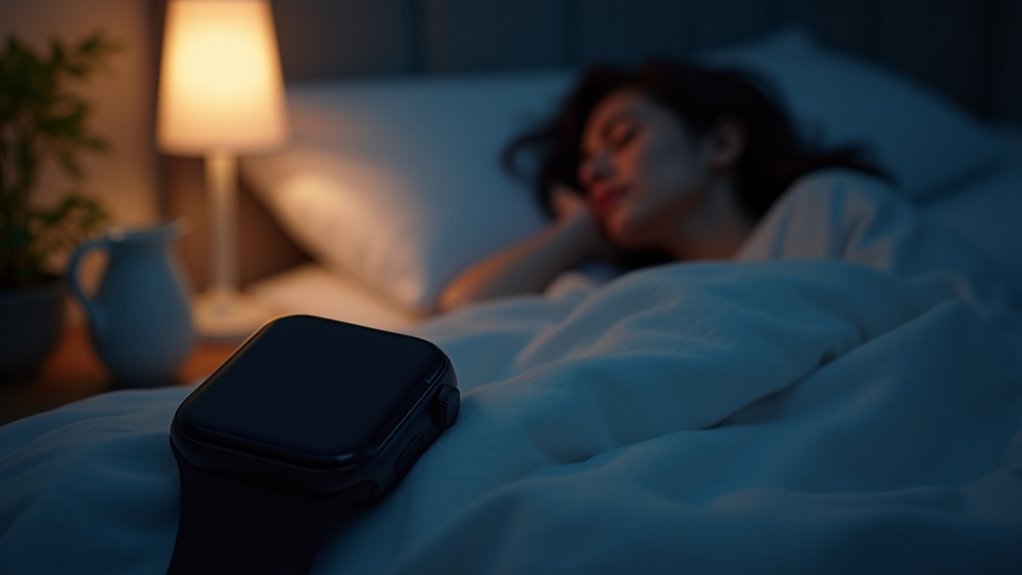
Beyond movement and temperature sensors, your sleep tracker’s microphone transforms nighttime sounds into valuable health data. Your device captures snoring patterns, analyzing frequency, duration, and intensity to detect sleep disturbances and potential breathing disorders.
It monitors ambient noise levels, identifying environmental factors that disrupt your sleep quality. The microphone works alongside other sensors to detect apnea events by recognizing breath breaks and gasps. This audio analysis helps differentiate between simple snoring and serious breathing interruptions, flagging irregular patterns for clinical evaluation.
Sound data also validates sleep stage estimates, cross-checking accelerometer and heart rate readings for accurate phase classification. Advanced algorithms can classify the severity of sleep apnea using standardized medical indices developed in collaboration with sleep physicians. Your audio recordings are processed on-device or through encrypted services, with minimal raw data stored to protect your privacy.
Sleep Environment Factor Monitoring
Your wearable doesn’t just track what’s happening inside your body—it monitors the environment around you while you sleep.
Advanced devices measure skin temperature fluctuations that reveal how your bedroom’s warmth affects your sleep quality and stage shifts. Light sensors detect ambient brightness levels, identifying circadian rhythm disruptions from artificial lighting or inadequate darkness. Some wearables even capture noise levels through microphones, quantifying disturbances from snoring, traffic, or other environmental sounds. Unlike traditional polysomnography testing conducted in clinical settings, wearables allow you to gather this comprehensive environmental data while sleeping comfortably in your own familiar bedroom.
Environmental factors that might be sabotaging your sleep:
- Temperature swings causing restless nights and frequent awakenings
- Unwanted light exposure preventing deep, restorative sleep phases
- Disruptive noise pollution fragmenting your sleep architecture
- Poor air quality affecting your breathing and comfort levels
- Uncomfortable humidity impacting your skin and respiratory health
This thorough environmental data helps you optimize your sleep sanctuary.
Smart Alarm and Wake-Up Optimization
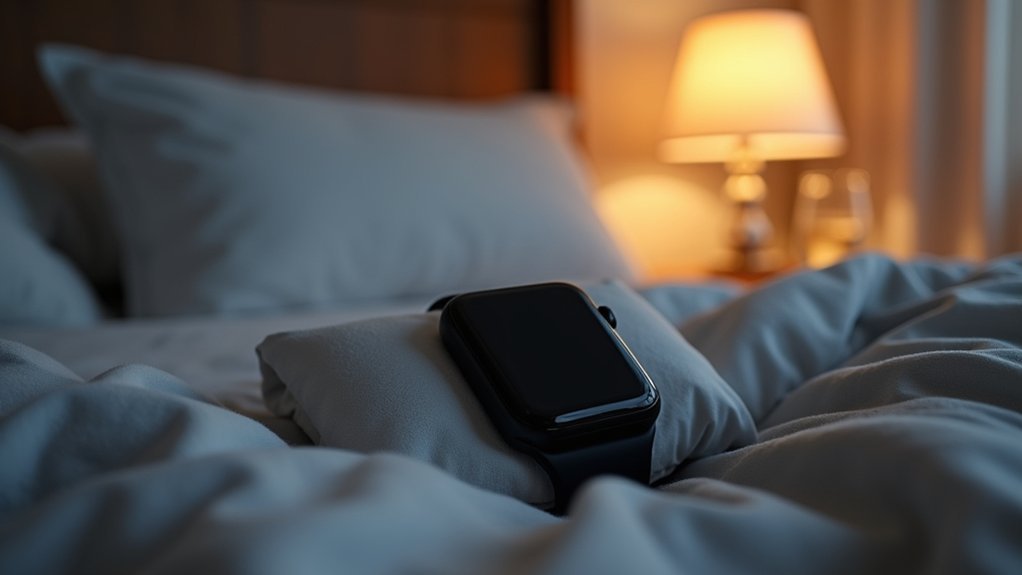
When your wearable detects you’re in light sleep rather than deep slumber, its smart alarm gently nudges you awake at the ideal moment within your preset wake-up window.
Smart wearables monitor your sleep cycles to wake you during lighter phases, ensuring you feel refreshed instead of groggy.
You can set this window anywhere from 10 to 45 minutes, with 30 minutes being the sweet spot for most users.
Your device uses accelerometer data and sound analysis to identify sleep phases, tracking movements and sounds like snoring or shifting positions.
This eliminates sleep inertia—that groggy feeling from waking during deep sleep.
You’ll customize snooze functions through phone interactions like double-tapping or shaking. The patented sound detection technology continuously monitors your sleep environment to optimize the wake-up process.
Many apps integrate with health platforms and offer gentle melodies or simulated sunrise lighting.
The result? You’ll wake up naturally refreshed instead of jarred awake.
Sleep Enhancement Tools and Guided Features
While smart alarms optimize when you wake up, sleep enhancement tools work throughout the night to improve how well you actually sleep. Your wearable becomes a personal sleep coach, monitoring your heart rate variability, breathing patterns, and brain activity to provide real-time guidance.
These devices don’t just track—they actively help you sleep better:
- Guided breathing exercises triggered when stress markers spike during the night
- Real-time coaching suggestions based on your detected sleep stages and disturbances
- Environmental optimization tips from noise, temperature, and light monitoring
- Personalized relaxation protocols delivered through integrated apps
- Dynamic sleep stage enhancement using auditory stimulation timed with your natural cycles
Your wearable adapts its recommendations based on your compliance and sleep trends, creating a truly personalized approach to better rest. Research shows that nearly a quarter of users have successfully adjusted sleep habits or made environmental changes based on the data and insights provided by their wearable devices.
Data Integration and Long-Term Trend Analysis
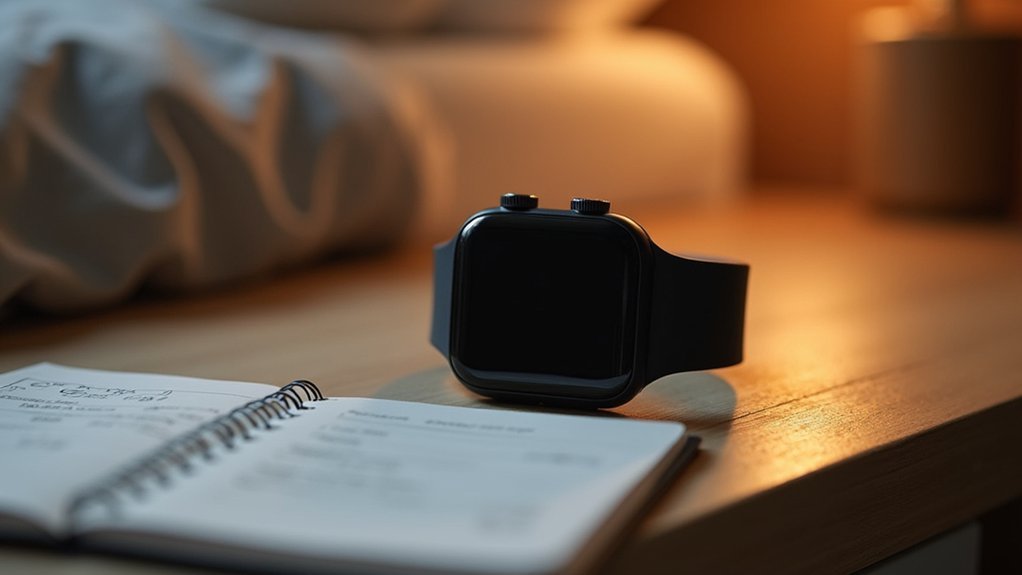
Beyond nightly coaching, your wearable’s true power emerges through extensive data integration and long-term pattern recognition. Your device continuously captures multiple biosignals—heart rate, temperature, movement, and electrodermal activity—creating thorough datasets that reveal meaningful health insights over weeks and months.
Advanced mathematical tools like particle filters combine your wearable data with lab results and surveys, improving accuracy of sleep and circadian assessments. You’ll discover patterns linking sleep quality to other health metrics, enabling trend analysis that identifies gradual changes often missed in single-night observations.
However, data integration faces challenges. Different devices use varying algorithms and terminology, requiring harmonization for valid comparisons. Your device might classify “light sleep” differently than others, affecting longitudinal analysis accuracy and cross-platform data interpretation. Cloud systems enable users to access their sleep analysis from various devices in different locations, enhancing the flexibility of long-term health monitoring.
Accuracy Limitations and Clinical Considerations
Despite impressive technological advances, your wearable’s sleep tracking accuracy remains notably limited compared to clinical gold standards. Consumer devices show only moderate to fair agreement with polysomnography, with Cohen’s κ values between 0.2 and 0.6. Your device likely overestimates sleep time and efficiency, potentially masking real sleep quality issues.
Critical accuracy limitations include:
- Sleep stage misclassification – distinguishing between light, deep, and REM sleep remains unreliable.
- Missed wake periods – brief nighttime awakenings often go undetected, inflating sleep continuity scores.
- Sleep disorder interference – accuracy degrades notably if you have sleep apnea or other conditions.
- Sensor constraints – lack of brain wave monitoring limits detection of true sleep states.
- Algorithm variability – proprietary methods create inconsistent results between brands.
For individuals with insomnia or chronic sleep difficulties, motion-based sensors create particularly misleading interpretations that can worsen anxiety about sleep quality.
Frequently Asked Questions
Can Sleep Wearables Detect Sleep Disorders Like Sleep Apnea or Insomnia?
Sleep wearables can detect patterns suggesting sleep apnea through breathing irregularities and snoring, plus insomnia through frequent awakenings. However, they’re not diagnostic tools—you’ll need professional evaluation for confirmation.
How Long Do Sleep Tracking Wearables Need to Charge Daily?
You’ll typically need 20-45 minutes daily charging for most sleep wearables like Apple Watch. However, longer-lasting devices like Whoop 4.0 only require charging every 7-10 days, minimizing tracking interruptions.
Are Sleep Wearables Safe to Wear Every Night Long-Term?
You can safely wear sleep trackers nightly long-term. They use non-ionizing sensors with minimal health risks. You might experience occasional skin irritation, but there aren’t verified adverse effects from continuous use.
Do Sleep Wearables Work for Shift Workers or Irregular Schedules?
You’ll find sleep wearables less accurate with irregular schedules since algorithms expect normal sleep patterns. However, Sleep Cycle adapts with customizable wake windows and tracks trends that help shift workers monitor sleep quality.
Can Multiple People Share One Sleep Tracking Wearable Device?
You can’t effectively share one sleep tracking wearable between multiple people. The device will mix up your individual biometric data, causing inaccurate readings and making personalized sleep analysis impossible for everyone involved.
In Summary
You’ll find that sleep wearables track movement, heart rate, and breathing patterns to estimate your sleep stages, but they’re not medical devices. While they can’t perfectly replicate sleep lab accuracy, they’ll give you valuable insights into your rest patterns and help optimize your sleep habits. Don’t rely on them for diagnosing sleep disorders, but you can use their data to identify trends and make lifestyle adjustments for better sleep quality.

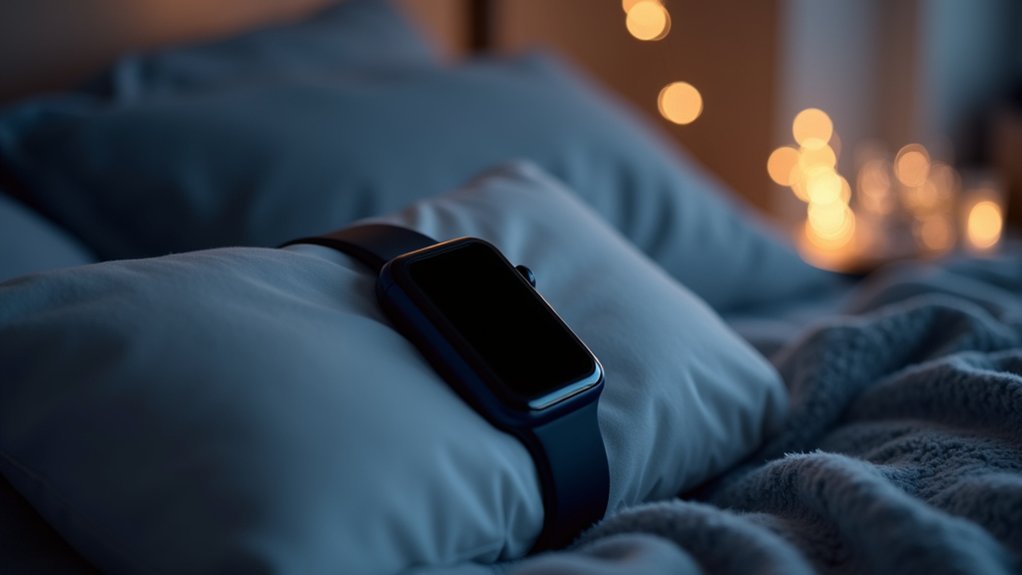
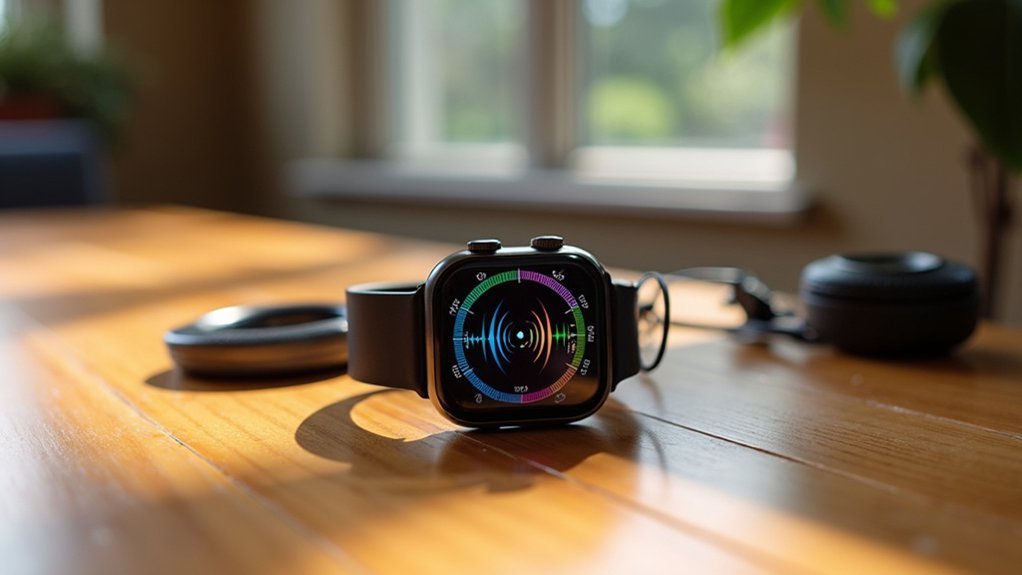
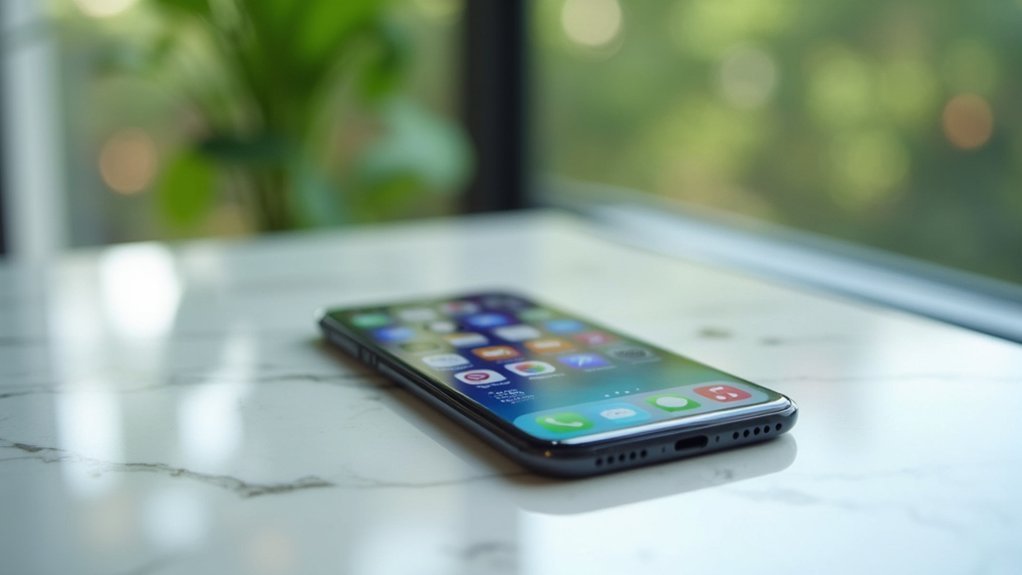
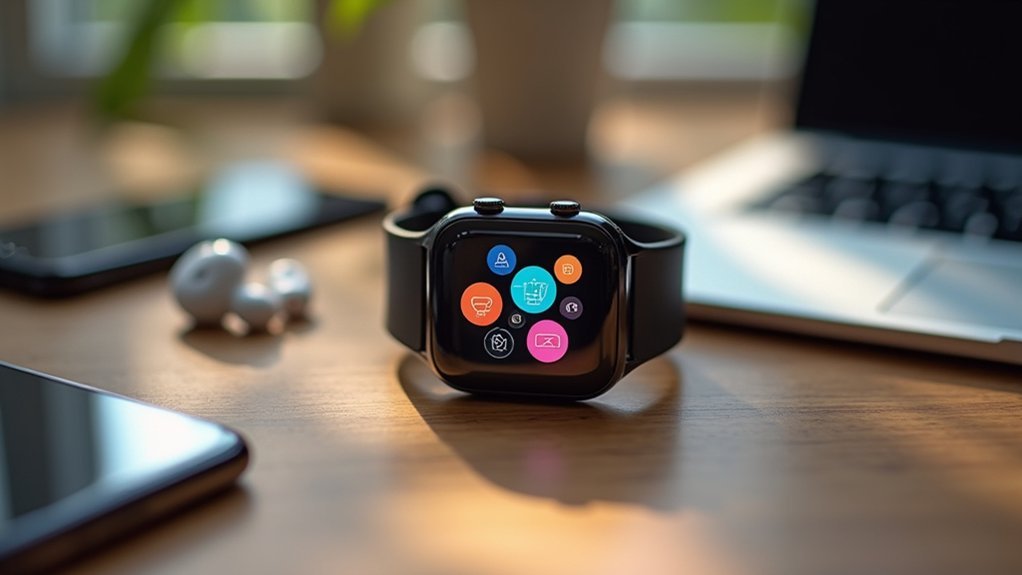
Leave a Reply